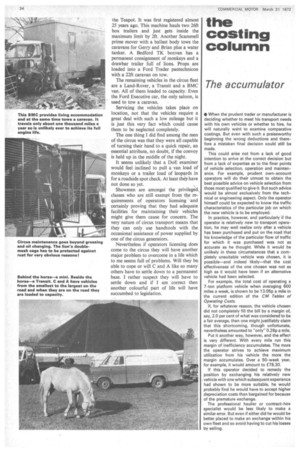the costing column
Page 36

If you've noticed an error in this article please click here to report it so we can fix it.
The accumulator
• When the prudent trader or manufacturer is deciding whether to meet his transport needs with his own vehicles or whether to hire, he will naturally want to examine comparative costings. But even with such a praiseworthy beginning the wrong deductions and therefore a mistaken final decision could still be made.
This could arise not from a lack of good intention to arrive at the correct decision but from a lack of expertise as to the finer points of vehicle selection, operation and maintenance. For example, prudent own-account operators will do their utmost to obtain the best possible advice on vehicle selection from those most qualified to give it. But such advice would be almost exclusively from the technical or engineering aspect. Only the operator himself could be expected to know the traffic characteristics of the particular job on which the new vehicle is to be employed.
In practice, however, and particularly if the operator is relatively new to transport operation, he may well realize only after a vehicle has been purchased and put on the road that his knowledge of the particular flow of traffic for which it was purchased was not as accurate as he thought. While it would be unlikely in these circumstances that a completely unsuitable vehicle was chosen, it is possible—and indeed likely—that the cost effectiveness of the one chosen was not as high as it would have been if an alternative vehicle had been selected.
For example, the total cost of operating a 7-ton platform vehicle when averaging 600 miles a week, is shown to be 13.05p a mile in the current edition of the CM Tables of Operating Costs.
If, for whatever reason, the vehicle chosen did not completely fill the bill by a margin of, say, 2.0 per cent of what was considered to be a fair average, then one might justifiably claim that this shortcoming, though unfortunate, nevertheless amounted to "only" 0.26p a mile.
Put it another way, however, and the effect is very different. With every mile run this margin of inefficiency accumulates. The more the operator strives to achieve maximum utilization from his vehicle the more the margin accumulates. Over a 50-week year, for example, it would amount to 08.30.
If this operator decided to remedy the position by exchanging his relatively new . vehicle with one which subsequent experience had shown to be more suitable, he would probably find he would have to accept higher depreciation costs than bargained for because of the premature exchange.
. The professional haulier or contract-hire specialist would be less likely to make a similar error. But even if either did he would be better placed to make an exchange within his own fleet and so avoid having to cut his losses by selling.




















































































